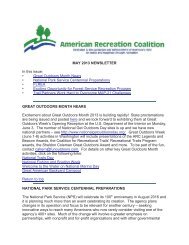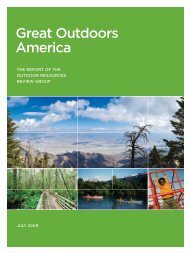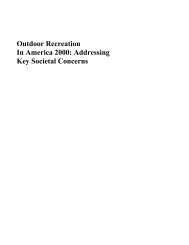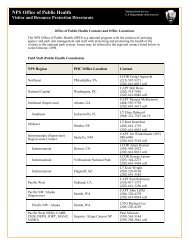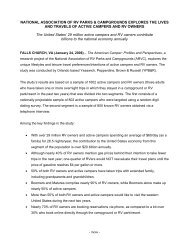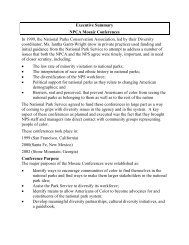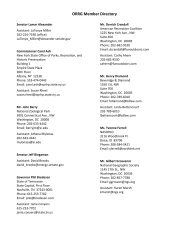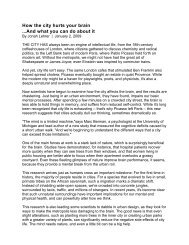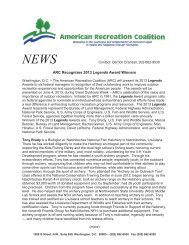Fish Habitat & Handling
Fish Habitat & Handling
Fish Habitat & Handling
You also want an ePaper? Increase the reach of your titles
YUMPU automatically turns print PDFs into web optimized ePapers that Google loves.
<strong>Fish</strong> <strong>Habitat</strong> & <strong>Handling</strong><br />
One of Six Stations in the Passport Program: An Introduction to <strong>Fish</strong>ing and Boating<br />
Read before the Event<br />
Objectives:<br />
At the end of this station participants will:<br />
√ Know the importance of watersheds to fish and humans,<br />
√ Understand the term “habitat” and its importance,<br />
√ Understand what fish need to survive,<br />
√ Understand how water can be polluted,<br />
√ Know one method of releasing a fish,<br />
√ Know the parts of a fish that require care in touching.<br />
Passport to <strong>Fish</strong>ing and Boating (2003) – <strong>Fish</strong> <strong>Habitat</strong> and <strong>Handling</strong><br />
Artwork: <strong>Fish</strong> <strong>Handling</strong> Poster © Ted Walke
Background for the Volunteer:<br />
At first glance fish seem very different from humans. How can we really understand<br />
what they are about? We breathe and move about in air: fish breathe and move about<br />
in water. We have hands and arms and legs to touch and reach and move: fish have<br />
fins for balance and movement, and feel with a sensitive collection of nerves on their<br />
sides. We protect ourselves by shielding our bodies with inventions like shoes and<br />
hats: fish protect themselves with built-in spiny fins. We have noses that help us smell<br />
and breathe: fish have nares, an indentation above their mouths that enables a very<br />
keen sense of smell but not breathing. We have skin that feels dry to the touch: fish<br />
have a layer of slime covering their bodies.<br />
But, in spite of our differences, humans and the fish are linked in very basic ways. Not<br />
only do we share similar organs and structures like backbones, eyes, teeth, and<br />
mouths. We also share waters, and watersheds (the land area drained by a specific<br />
river). Watersheds are named for the river that drains them, but they are 99% land.<br />
Humans live on that land and almost everything that humans do there effects what<br />
happens in the river.<br />
Healthy places for both fish and humans begin on the land. Melting snow and rain<br />
wash the land surface as they drain into the creek, taking with them not only nutrients<br />
from the land but also trash and pollutants like oil, fertilizers, pesticides, soap suds,<br />
and animal waste. Anglers and boaters want healthy water for fish to live in along with<br />
places for fish to rest and hide and eat. Keeping the watershed healthy is the first<br />
step toward having good places available to spend a lifetime of recreation.<br />
This station not only provides a chance to learn about and understand our watershed,<br />
but also some information to aid participants when they catch fish. <strong>Fish</strong> live in a world<br />
of predator and prey, where they either eat or get eaten; where they are wary of<br />
movement and sound. Keen senses help them survive. The fish has built-in ways to<br />
discourage predators (including humans) from catching it. They include a slippery<br />
layer on the outside of the body so they are difficult to hold onto and a very wide field<br />
of vision so sneaking up on them is difficult.<br />
Even when we catch a fish, the fish still has a few tricks up its “sleeve.” Wounds from<br />
fishing are rare, but it is good to know how to avoid them. A spiny dorsal (top) fin can<br />
be pressed downward toward the fish’s body in a motion that is like petting a fish. The<br />
spiny fin can lie against the body if you pet from head to tail. Your hand then holds<br />
the fish from the front just behind its head (see <strong>Fish</strong> <strong>Handling</strong> poster). A catfish has<br />
Passport to <strong>Fish</strong>ing and Boating (2003) – <strong>Fish</strong> <strong>Habitat</strong> and <strong>Handling</strong><br />
Artwork: <strong>Fish</strong> <strong>Handling</strong> Poster © Ted Walke<br />
2
spines at both the dorsal (top) and pectoral (gill) fins that can give a painful puncture<br />
prone to infection. <strong>Handling</strong> a catfish means carefully avoiding the top and gill fin<br />
spines. Some fish do have teeth that can puncture or cut your skin. It is best to avoid<br />
putting your fingers into the fish’s mouth. Some fish also have sharp gill covers that<br />
can cause bad cuts, so be careful with the gills and gill cover.<br />
On the other hand, if we are going to release the fish, it is also possible for us to<br />
damage it. We need to take care to keep its outside slime layer intact. Dry hands<br />
cause the slime to stick to us rather than the fish. Wetting your hands before you<br />
touch the fish helps keep the slime layer where it belongs. Participants should also<br />
know that the gills and eyes on a fish are very delicate. Touching the gills damages a<br />
fish’s ability to remove oxygen from the water and so the fish cannot breathe.<br />
Bleeding from the gills indicates the fish is not likely to survive if released.<br />
A fish to be released and caught again another day, needs to be treated gently and<br />
handled as little as possible. Two things may happen with beginners: either they drop<br />
the fish, or get hold of it and squeeze too hard. Dropping a fish, either on land or in<br />
the boat, can cause internal wounds that can be fatal. A dropped fish, if it is legal to<br />
keep, should not be released. If you must release it, then take comfort in the fact that<br />
nothing in nature is wasted. A dead fish will be recycled by providing nutrients to<br />
others.<br />
If you are using a barbless hook, it is possible to release a fish by keeping the fish in<br />
the water. Move your hand down the line until you can get hold of the hook, and then<br />
turn the hook upside down. The fish generally will not turn upside down, falling back<br />
into the water. If that doesn’t work and touching the fish is necessary, keep it in the<br />
water and wet your hands before touching. If you must remove the fish from the<br />
water, keep it out of the water only as long as you can hold your breath.<br />
A fish will sometimes swallow the hook, making it impossible to reach. If this happens<br />
then it is proper to cut the line, leaving the hook embedded in the fish. Hooks rust out<br />
or are absorbed fairly quickly. The fish has more of a chance of survival if the hook is<br />
left in place than if it is ripped out of the fish’s mouth.<br />
The program to be presented at this station follows the Materials section below. It<br />
appears in two forms, a script and an outline, so you can choose the one that will help<br />
you most with your presentation. If you feel more comfortable using a script, the part<br />
directly following the Materials section is for you. Those presenters who would rather<br />
read through the script and then use an outline as a guide will find a suggested<br />
outline following the script.<br />
Passport to <strong>Fish</strong>ing and Boating (2003) – <strong>Fish</strong> <strong>Habitat</strong> and <strong>Handling</strong><br />
Artwork: <strong>Fish</strong> <strong>Handling</strong> Poster © Ted Walke<br />
3
Teaching Tips for <strong>Fish</strong> <strong>Habitat</strong> and <strong>Handling</strong>:<br />
Make sure all of the needed teaching tools and equipment are handy. Lay the items<br />
out so you can find them easily. Prepare in advance. If you need the script for the first<br />
couple of times through, you might consider putting it on a clipboard with a rubber<br />
band to keep it from flapping in the wind. Have some rocks or weights on hand to<br />
anchor your props in case a breeze comes up. The watershed model, in particular,<br />
may need to be held to the ground in the wind.<br />
Seat your audience on the ground or a tarp, facing you. Make sure they are not<br />
looking in the direction of some other interesting and distracting activity.<br />
This Station uses two different posters to show what a good habitat looks like and<br />
how to hold onto fish. Displaying the posters close to the participants is very<br />
important. If they are 20 feet from the posters they cannot have much impact. If it is<br />
impossible to move the posters close to the participants, then move the participants<br />
close to the posters. Having your audience get up and move to a poster hanging on<br />
the fence will help them focus on the things you want them to see. Having a couple of<br />
people hold up the poster can also be effective and has an added benefit: it gives a<br />
restless participant something constructive to do.<br />
Engage the parents and the kids in your activity. Adults generally need to be invited<br />
to participate. A talking group of parents in the background is very distracting and<br />
these activities are designed to include all members of the family, so invite them in<br />
and sit them down with the group.<br />
The watershed-building activity uses spray bottles to wet down crumpled paper. You<br />
will need a new piece of paper for each group and a way to dispose of the used wet<br />
paper when you are finished with it. Ideally, this activity takes place outside where<br />
spilled water or over spray is not a problem. If you are presenting this program inside<br />
you will need a large piece of plastic to protect the floor and a sponge to mop up spills<br />
between groups.<br />
Encourage your audience to participate. Let them get their hands on the fish models<br />
and help with the watershed. Respond to wrong answers with, “Can you think of<br />
something else?”<br />
Passport to <strong>Fish</strong>ing and Boating (2003) – <strong>Fish</strong> <strong>Habitat</strong> and <strong>Handling</strong><br />
Artwork: <strong>Fish</strong> <strong>Handling</strong> Poster © Ted Walke<br />
4
Watch your timing. Take as long as the activity needs to make your points and to let<br />
the participants have fun while doing the activities. The watershed model is<br />
particularly adaptable to using more or less time. If you have more time let the<br />
coloring of the watershed elements take longer by involving more participants in the<br />
coloring. If you need to save time on this one, handle the “rain” squirt bottle yourself,<br />
or color the model yourself from suggestions your audience gives you for placement<br />
of the city, forests, etc. If your audience is young substitute the word “home” for<br />
“habitat.”<br />
If one child is distracting the others by being wiggly or talkative, give him a task to<br />
help you in some way. Make sure it is a task that requires him to be still. You might<br />
have him hold a poster or prop so everyone can see. If the child is too young for the<br />
activity, let him play with one of the teaching tools.<br />
Passport to <strong>Fish</strong>ing and Boating (2003) – <strong>Fish</strong> <strong>Habitat</strong> and <strong>Handling</strong><br />
Artwork: <strong>Fish</strong> <strong>Handling</strong> Poster © Ted Walke<br />
5
Materials needed:<br />
● Comfortable and attractive life jacket for the presenter to wear throughout<br />
the program<br />
<strong>Fish</strong> <strong>Habitat</strong>:<br />
● 1 piece of white easel paper about 27” by 34” for each group<br />
● 2 spray bottles filled with water, nozzle adjusted to fine mist<br />
● 1 or 2 colors of liquid food color (tiny squeeze bottles work well)<br />
Customize by using mixed food colors to represent pollution sources that<br />
are a significant problem in your area: brown=silt, brown = animal waste,<br />
blue= fertilizers and pesticides, red = waste oil or runoff from city streets.<br />
● 4 permanent markers with fat tips to represent permanent parts of the<br />
landscape: brown (mountains and rocky cliffs), green (forests and stream<br />
buffers), blue (rivers and streams), black (cities, asphalt, buildings, highways) or<br />
other colors of your choice<br />
● Twig to act as a “log” on the watershed model, or grass (whatever is<br />
appropriate in your area)<br />
● Small pebbles to put onto the model as “structure”<br />
● Healthy <strong>Habitat</strong> Poster showing cross section of bodies of water with food<br />
chains, structure, spawning habitat, and people fishing and boating<br />
Passport to <strong>Fish</strong>ing and Boating (2003) – <strong>Fish</strong> <strong>Habitat</strong> and <strong>Handling</strong><br />
Artwork: <strong>Fish</strong> <strong>Handling</strong> Poster © Ted Walke<br />
6
<strong>Fish</strong> <strong>Handling</strong>:<br />
● 2 rubber fish from the Passport Materials Kit or fish shaped pillows<br />
● Slimy stuff to feel: a plastic covered index card with a picture of a fish on it<br />
from the Passport Materials Kit, or download the image to print and laminate,<br />
from www.National<strong>Fish</strong>ingandBoatingWeek.org. Put a little vegetable oil or<br />
hand cream on the outside.<br />
● Short, rigged fishing rod with 2/0 hook, hook’s barbs and point filed so it isn’t<br />
sharp. If you do not have a short fishing rod you might want to use just the top<br />
half of a larger rod.<br />
● One 8” plastic bait fish hooked to the fishing rod so it can be unhooked as a<br />
demo. Two fish are included in the Passport Materials Kit or can be ordered<br />
from a saltwater fishing equipment catalog.<br />
● <strong>Fish</strong> <strong>Handling</strong> Poster showing different fish and how to hold them from the<br />
Passport Materials Kit or download the image to print and laminate from<br />
www.National<strong>Fish</strong>ingandBoatingWeek.org.<br />
Passport to <strong>Fish</strong>ing and Boating (2003) – <strong>Fish</strong> <strong>Habitat</strong> and <strong>Handling</strong><br />
Artwork: <strong>Fish</strong> <strong>Handling</strong> Poster © Ted Walke<br />
7
SCRIPT STARTS HERE<br />
Estimated time for this section (<strong>Fish</strong> <strong>Habitat</strong>): 7 minutes<br />
Presenter says words in bold; Participants give answers in italics;<br />
Presenter and participants do the actions in the boxes.<br />
Watch for check marked “√Objectives” in the left column to see that you are<br />
covering the essential information.<br />
Tips, Objectives, SCRIPT:<br />
Your Notes, etc.:<br />
Do you want to catch fish? (Yes!)<br />
Display poster showing<br />
healthy habitat:<br />
► Teaching Tip:<br />
For younger children use<br />
the word “home” instead<br />
of “habitat.”<br />
►Teaching Tip:<br />
Point to the poster<br />
I’m (your name).<br />
Passport to <strong>Fish</strong>ing and Boating (2003) – <strong>Fish</strong> <strong>Habitat</strong> and <strong>Handling</strong><br />
Artwork: <strong>Fish</strong> <strong>Handling</strong> Poster © Ted Walke<br />
I’m going to help you catch fish by helping you<br />
understand some things about:<br />
●fish<br />
●where they live.<br />
If you know an answer to a question say it loud so we<br />
can all hear.<br />
As we are going through the program if you don’t<br />
understand what we are doing, please ask about it.<br />
Our time is limited, so let’s get going.<br />
We are closely linked to the fish we catch by more<br />
than a fishing line. <strong>Fish</strong> and humans, no matter where<br />
we live, share a watershed. We both need healthy<br />
water. If you want to go fishing and boating you need<br />
a healthy place for fish to live. Scientists call those<br />
places “habitats.”<br />
Healthy habitats for fish look like this.<br />
8
√ Objective:<br />
Understand the term<br />
“habitat” and its<br />
importance<br />
√ Objective:<br />
Know the importance<br />
of watersheds to fish<br />
and humans.<br />
Passport to <strong>Fish</strong>ing and Boating (2003) – <strong>Fish</strong> <strong>Habitat</strong> and <strong>Handling</strong><br />
Artwork: <strong>Fish</strong> <strong>Handling</strong> Poster © Ted Walke<br />
What do you see on this poster that makes it a good<br />
“habitat” for fish to live in?<br />
water<br />
food<br />
places for the fish to hide when trying to escape a<br />
predator, or to rest<br />
places for the fish to lay eggs and have young<br />
We are going to make a model watershed so you can<br />
understand a little about how a watershed works. A<br />
watershed is:<br />
●An area that drains into a river or stream<br />
●99% is land, 1% is water<br />
●A healthy watershed means good places to<br />
fish and boat.<br />
Here’s a box of watershed stuff. We can make a<br />
model place for fish and us to live.<br />
I need a volunteer to start this paper watershed. Who<br />
would take this paper and wad it up into a ball?<br />
Choose a volunteer to wad up the paper<br />
Now we’ll pull it apart until it looks something like the<br />
landscape around here. We can make mountains,<br />
valleys, rivers and towns but we want whatever rain<br />
that falls onto our watershed to drain down to our<br />
place to fish and boat just like a real watershed.<br />
Pull the paper lightly apart to make landforms. Try<br />
to identify an area in the crumpled paper that is<br />
similar to where you live.<br />
9
► Teaching Tip:<br />
Use as many participants<br />
as you can to color the<br />
watershed. Only do it<br />
yourself if you need to<br />
save time.<br />
√ Objective:<br />
Understand what fish<br />
need to survive<br />
Passport to <strong>Fish</strong>ing and Boating (2003) – <strong>Fish</strong> <strong>Habitat</strong> and <strong>Handling</strong><br />
Artwork: <strong>Fish</strong> <strong>Handling</strong> Poster © Ted Walke<br />
Hey that was quick. Here’s our watershed. See, it has<br />
mountains, hills, tablelands (or whatever your<br />
landscape looks like) just like we have around here.<br />
Where would our town be? Make it black.<br />
Take these markers and color in the features of the<br />
watershed.<br />
Have the kids use the permanent markers for<br />
permanent features of your landscape<br />
Do we live in a valley or on a mountaintop?<br />
Where does our water come from?<br />
Reservoir? Wells? River?<br />
There must be forests and other green buffers too.<br />
Use this green marker to color in those areas.<br />
We’ll need some dirt somewhere. Or cliffs? Or<br />
mountains? That can be brown.<br />
Blue is for water. Where is our water supply?<br />
Looks pretty good, doesn’t it?<br />
<strong>Fish</strong> like structure to hide under or around. They like<br />
logs, brush piles, rocks, docks; things that give<br />
shelter or shade. They hang out there.<br />
This is a fish “home” so the structure is like the<br />
furniture in our home. Put some of these twigs and<br />
pebbles onto the model to make good places for fish<br />
to live and for us to catch fish.<br />
10
√ Objective:<br />
Understand what fish<br />
need to survive.<br />
√ Objective:<br />
Understand how<br />
water can be<br />
polluted.<br />
Passport to <strong>Fish</strong>ing and Boating (2003) – <strong>Fish</strong> <strong>Habitat</strong> and <strong>Handling</strong><br />
Artwork: <strong>Fish</strong> <strong>Handling</strong> Poster © Ted Walke<br />
Place the twig and some piles of pebbles onto the<br />
model for good places for fish to hide from<br />
predators or to rest.<br />
Now we have a great place for both the fish and us.<br />
Look at the poster again. Can you find places for the<br />
fish to hang out on the poster like we put into our<br />
watershed?<br />
Is there food for each of the creatures to eat?<br />
Do you see places that you could fish?<br />
Participants point to places where they would fish<br />
That’s good. Now let’s see what happens if there are<br />
problems in the watershed. When it rains the water<br />
washes the land and whatever was on the land ends<br />
up in the river or the lake. Remember that a<br />
watershed is 99% land so it is washing a lot of space<br />
and running the water into a much smaller place.<br />
People who don’t know better might pollute the water<br />
by pouring waste oil or dumping bug spray or<br />
throwing trash on the land.<br />
We’ll pretend this food coloring shows where<br />
someone dumped oil from their car or just let it drain<br />
on the ground. I’ll put it here and here on the model.<br />
Now we will make it rain and we’ll see what happens.<br />
11
√ Objective:<br />
Know the importance<br />
of watersheds to fish<br />
and humans<br />
► Teaching Tip:<br />
Use the Healthy <strong>Habitat</strong><br />
poster. There is no way<br />
for someone who has<br />
never seen a good habitat<br />
to imagine the complexity<br />
of this natural system.<br />
Passport to <strong>Fish</strong>ing and Boating (2003) – <strong>Fish</strong> <strong>Habitat</strong> and <strong>Handling</strong><br />
Artwork: <strong>Fish</strong> <strong>Handling</strong> Poster © Ted Walke<br />
Give the squirt bottles to two volunteers to spray<br />
the paper watershed. Spray a lot! Make lakes.<br />
Watch the colors run into every part of the water.<br />
What happened? (The water was polluted.)<br />
We do not want that to happen to places we fish and<br />
boat. We need healthy water for the fish to live in and<br />
for us to play on too. Would you want to boat or water<br />
ski in this polluted water?<br />
What would you do if you saw trash in the water?<br />
Pick it up and take it to the garbage can.<br />
You know we all have water that can be polluted<br />
because “We all live downstream.” No matter where<br />
you live you receive water that passed by someone<br />
else first. Keep oil and pollutants and trash out of our<br />
watershed so we have good places to fish and boat.<br />
Anglers and boaters want our fishing places to look<br />
like this. (Point to poster)<br />
What did you learn?<br />
Keep pollution out of our watershed.<br />
Continue: Estimated time for this section about <strong>Fish</strong> <strong>Handling</strong>: 8 minutes<br />
Tips, Objectives, SCRIPT:<br />
Your notes, etc.:<br />
Let’s get up close and personal with a fish. Knowing<br />
some “personal” things about fish will help you be<br />
better anglers.<br />
12
√ Objective:<br />
Know one method of<br />
releasing a fish<br />
√ Objective:<br />
Understand what fish<br />
need to survive<br />
Passport to <strong>Fish</strong>ing and Boating (2003) – <strong>Fish</strong> <strong>Habitat</strong> and <strong>Handling</strong><br />
Artwork: <strong>Fish</strong> <strong>Handling</strong> Poster © Ted Walke<br />
Let’s say you are fishing and catch a fish that is too<br />
little to keep. There it is on the end of your fishing<br />
line.<br />
●What do you do? Let it go.<br />
●Drag it up on the bank and fling it all<br />
around? NO! You’re right. You must be gentle.<br />
●Dropping a fish can injure it so it dies later.<br />
You must be gentle with it.<br />
How can you get the fish off the hook?<br />
You must take it off<br />
You should as gently as possible take it off. You can<br />
have somebody help you if you want. The first thing<br />
to try is to:<br />
● Leave the fish in the water<br />
● Hold your rod up in the air<br />
● With your hand, follow the line down until you<br />
can get hold of the hook<br />
● Turn the hook upside down<br />
Demonstrate, using your fishing rod with the<br />
plastic bait fish hooked on the end – Let one<br />
participant hold the fish and move it back and<br />
forth as you move your hand down to hold the<br />
hook and turn it upside down<br />
Usually the fish flops off because it does not turn<br />
upside down. If this does not work then you must go<br />
to the next step and it involves slime.<br />
If that doesn’t work then you need to get hold of the<br />
fish to remove the hook.<br />
13
Display the <strong>Fish</strong> <strong>Handling</strong><br />
poster:<br />
√ Objective:<br />
Know the parts of a<br />
fish that require care<br />
in handling<br />
Feel this slimy stuff.<br />
Passport to <strong>Fish</strong>ing and Boating (2003) – <strong>Fish</strong> <strong>Habitat</strong> and <strong>Handling</strong><br />
Artwork: <strong>Fish</strong> <strong>Handling</strong> Poster © Ted Walke<br />
Pass around the card with “slime” on it.<br />
That’s the way a fish feels on the outside. This slime<br />
protects the outside of the fish and makes it slippery.<br />
What do you think would happen to a fish if it loses<br />
too much of its slime?<br />
It would die.<br />
Yup, belly up. So we want to keep the slime on the<br />
fish if we are releasing it to grow some more.<br />
●Our skin is dry and fish are wet.<br />
●If our dry skin touches the fish its slime comes<br />
off on our hands.<br />
This is VERY IMPORTANT:<br />
To keep the slime on the fish, wet your hands<br />
before touching it.<br />
What do we do before handling a fish?<br />
Wet your hands.<br />
Here are some rubber fish for us to practice on.<br />
●We need to handle any fish that will be<br />
released gently.<br />
●Dropping a fish can hurt it but:<br />
<strong>Fish</strong> are slick on the outside<br />
Hold it firmly enough so it can’t get away<br />
Hold it softly enough so it isn’t injured<br />
But fish:<br />
●Live in a world of predators and prey where<br />
they either eat other fish or get eaten<br />
themselves<br />
14
Passport to <strong>Fish</strong>ing and Boating (2003) – <strong>Fish</strong> <strong>Habitat</strong> and <strong>Handling</strong><br />
Artwork: <strong>Fish</strong> <strong>Handling</strong> Poster © Ted Walke<br />
●Have built in protections on them that you<br />
should watch out for when you try to handle<br />
them<br />
●It’s easy if you know what to do.<br />
This one is a (bluegill or sunfish) with spiny fins on<br />
the top. But, the fin will lie down if you push it down<br />
from front to back – like petting a fish. Push the fin<br />
down and hold the fish at the front.<br />
Use a spiny finned rubber demo fish like a<br />
bluegill, sunfish or bass. Pass around the demo<br />
fish, pointing to the top and gill fins.<br />
Pass this around and show me how you would hold a<br />
spiny finned fish.<br />
Let everyone have a turn holding the demo fish.<br />
Show the spiny fin. Keep hands away from both<br />
the gills and the eyes on the fish.<br />
Now catfish are something else.<br />
●They have spines at both the top and gill fins<br />
that can give a painful puncture that gets<br />
infected easily.<br />
●So they require some careful handling to avoid<br />
those spines.<br />
●Look at the poster and see how to take hold of<br />
a catfish<br />
●What should you do first?<br />
Wet your hands<br />
15
Passport to <strong>Fish</strong>ing and Boating (2003) – <strong>Fish</strong> <strong>Habitat</strong> and <strong>Handling</strong><br />
Artwork: <strong>Fish</strong> <strong>Handling</strong> Poster © Ted Walke<br />
Show where the spines are on a catfish at both<br />
the top and gill fins.<br />
Pretending that this fish is a catfish, how would you<br />
hold it?<br />
Have participants show how to hold a catfish.<br />
See that everyone gets a turn.<br />
Other things to keep in mind when you are touching<br />
fish are that their gill covers can be sharp and the<br />
gills are very delicate. You can hurt the fish’s gills if<br />
you touch them.<br />
What are the gills for?<br />
To breathe<br />
Sure. The fish takes oxygen from the water with its<br />
gills. If you touch the gills, the fish will have trouble<br />
breathing.<br />
Even if you are going to kill the fish to eat it, we still<br />
treat it with the respect you give a living thing and so<br />
we do not touch the gills or the eyes. We do not<br />
cause any unnecessary damage.<br />
Take it out of the water for only as long as you can<br />
hold your breath, because the fish will not be able to<br />
get oxygen from the air like we do.<br />
Do fish have teeth?<br />
Yes (most do)<br />
What do you suppose you should do about that?<br />
Keep fingers out of its mouth<br />
16
► Teaching Tip:<br />
Use your demo fish and<br />
poster to help with the<br />
review. Point to the parts<br />
as the participants<br />
remember them.<br />
So, what parts of a fish can hurt you?<br />
gill cover<br />
spiny fins<br />
teeth<br />
spines on catfish<br />
Passport to <strong>Fish</strong>ing and Boating (2003) – <strong>Fish</strong> <strong>Habitat</strong> and <strong>Handling</strong><br />
Artwork: <strong>Fish</strong> <strong>Handling</strong> Poster © Ted Walke<br />
But a fish can get hurt too. What can YOU HURT if<br />
you touch or mishandle a fish?<br />
gills<br />
slime<br />
eyes<br />
So now you have hold of the fish with one hand. With<br />
the other hand take hold of the hook and remove it<br />
from its mouth.<br />
Do you know what to do if the fish has swallowed the<br />
hook? You cut the line and leave the hook in the fish.<br />
It is more likely to survive if the hook stays in than if<br />
you jerk it out. Most of the time, the hook will rust<br />
away in a short time.<br />
It’s time to wrap this up. Your Group Guide will ask<br />
you some questions and take you to the next station.<br />
It’s been nice talking to you. Bye.<br />
Group Guide’s Questions<br />
Ask these questions before taking the group to the next station:<br />
What parts of a fish can hurt you? (fins, gill cover, teeth)<br />
What parts of a fish can you hurt? (gills, slime coating)<br />
Before you touch a fish what do you do? (Wet your hands)<br />
How can you help protect your watershed? (Be careful not to pollute or<br />
litter)<br />
17
√ Objective:<br />
Understand<br />
the term<br />
“habitat”<br />
and its<br />
importance.<br />
√ Objective:<br />
Know the<br />
importance<br />
of<br />
watersheds<br />
to fish and<br />
humans.<br />
√ Objective:<br />
Understand<br />
how water<br />
can be<br />
polluted.<br />
OUTLINE STARTS HERE:<br />
Introduce yourself and the station<br />
<strong>Fish</strong> <strong>Habitat</strong> & <strong>Handling</strong> will help you catch fish by helping you<br />
understand them and where they live<br />
We are closely linked to the fish we catch by more than a fishing line<br />
Both fish and humans need:<br />
●healthy water<br />
●healthy watershed<br />
Healthy habitats for fish look like the poster<br />
What do you see that makes it good habitat?<br />
water,<br />
food,<br />
places to hide or rest,<br />
places to lay eggs and have young<br />
Build a model to help you see how a watershed works<br />
●Watersheds are 99% land and 1% water<br />
(wad up paper, pull apart to make model)<br />
●Take the markers and color in our town, mountains, forests,<br />
rivers<br />
●<strong>Fish</strong> like structure (like furniture in a home) They hang out<br />
there<br />
(Put twigs and pebbles onto model as good place for fish<br />
to live and us to fish)<br />
●Look at poster and identify structure, food for fish to eat. This<br />
is the way it should be<br />
Let’s see what happens when there is trouble in the watershed.<br />
●Rain washes the large amount of land and it all goes into the<br />
much smaller place filled with water<br />
●People who don’t know better pour oil or bug sprays or put<br />
trash on the land<br />
(Use food color to represent where someone changed oil<br />
or spilled bug spray or put trash on the land)<br />
●Make it rain. What happened?<br />
●We do not want that to happen to our places to fish and boat.<br />
●What would you do if you saw trash in the water?<br />
Passport to <strong>Fish</strong>ing and Boating (2003) – <strong>Fish</strong> <strong>Habitat</strong> and <strong>Handling</strong><br />
Artwork: <strong>Fish</strong> <strong>Handling</strong> Poster © Ted Walke<br />
18
√ Objective:<br />
Know one<br />
method of<br />
releasing<br />
fish.<br />
●We all live downstream!<br />
(Point to poster) Anglers and boaters want our fishing places to<br />
look like this.<br />
<strong>Fish</strong> parts<br />
●Knowing personal things about fish will help you be a better<br />
angler<br />
●What if you are fishing and you get a fish that is too little to<br />
keep?<br />
How can you get it off the hook?<br />
(Demonstrate following line down to get hold of hook,<br />
turn upside down)<br />
●If that doesn’t work go to next step – getting hold of the fish<br />
Need to know about Slime!<br />
(Feel slime, pass around)<br />
Slime protects fish – what happens if the fish loses its<br />
slime?<br />
Our skin is dry and fish are wet. The slime will stick to our<br />
dry √ Objective:<br />
skin.<br />
Understand<br />
what fish<br />
need to<br />
survive.<br />
Wet your hands.<br />
√ Objective:<br />
Know the<br />
parts of a<br />
fish that<br />
require care<br />
in handling.<br />
●Getting hold of a fish: (Rubber fish are for us to practice on.)<br />
Handle any fish gently.<br />
Dropping a fish can hurt it<br />
<strong>Fish</strong> live in a world of predators and prey<br />
●They have built in ways to protect themselves<br />
●They are easy to handle if you know what to do<br />
This one is a (bluegill) and it has spiny fins on top.<br />
●Pet it to lay the fin down – hold at the front<br />
(Pass it around and demonstrate.)<br />
Catfish:<br />
●Spines on both top and gill fins that can give a<br />
painful puncture that is easily infected<br />
●Look at poster to see how to handle<br />
●What should you do first? (Wet your hands.)<br />
(Pass around fish)<br />
Gills are delicate and gill covers can be sharp<br />
What are gills for?<br />
Even if you are going to kill the fish to eat it<br />
●Treat it with respect<br />
Passport to <strong>Fish</strong>ing and Boating (2003) – <strong>Fish</strong> <strong>Habitat</strong> and <strong>Handling</strong><br />
Artwork: <strong>Fish</strong> <strong>Handling</strong> Poster © Ted Walke<br />
19
●Do not cause any unnecessary damage<br />
●Take it out of the water only as long as you can hold<br />
your breath<br />
Do fish have teeth?<br />
What should you do about that?<br />
(keep fingers out of its mouth)<br />
What parts of a fish can hurt you?<br />
spiny fins<br />
teeth<br />
gill cover<br />
catfish spines<br />
What parts of a fish can you hurt?<br />
gills<br />
slime<br />
eyes<br />
So now you have hold of the fish. Hold in one hand, take out hook<br />
with other<br />
What happens if you cannot get hook out?<br />
●Cut the line and leave hook in fish<br />
●Hook will rust out<br />
●Do not pull the hook out<br />
It’s been nice. Bye.<br />
Group Guide asks questions.<br />
Passport to <strong>Fish</strong>ing and Boating (2003) – <strong>Fish</strong> <strong>Habitat</strong> and <strong>Handling</strong><br />
Artwork: <strong>Fish</strong> <strong>Handling</strong> Poster © Ted Walke<br />
20
Extensions: (If you have more time . . .)<br />
Cleaning a <strong>Fish</strong>:<br />
If your event includes an actual fishing experience, you may want to take advantage of<br />
the opportunity to demonstrate how to clean a fish. The demonstration keeps knives<br />
out of children’s hands but allows a careful exploration of how to get the edible parts<br />
for your use. Using a long flexible filet knife to remove a slice of meat from each side of<br />
the fish without gutting it (filleting) is an easy way to handle the demonstration. Some<br />
people prefer gutting the fish so the head can stay on for measuring and photos.<br />
Cooking fish:<br />
Another popular demonstration is cooking (and eating) freshly caught fish. Recipes<br />
vary from region to region but the result is universal, an enthusiastic response from<br />
hungry anglers.<br />
Passport to <strong>Fish</strong>ing and Boating (2003) – <strong>Fish</strong> <strong>Habitat</strong> and <strong>Handling</strong><br />
Artwork: <strong>Fish</strong> <strong>Handling</strong> Poster © Ted Walke<br />
21



